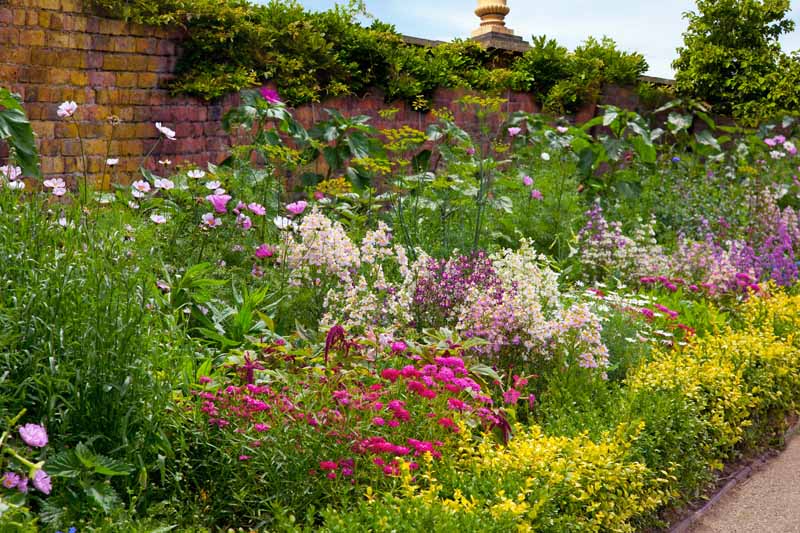by Bruce Bennett •
After a full season of flowering and surviving yet another sort of record heat wave, how have the flowering plants in your garden beds held up? If your annuals peaked too soon and now have one foot in the compost pile, or your perennials have bloomed-out and left you with a mass of nice greenery but no color, it might be time to think about adding some late-blooming perennials to your current plant mix.
September is a good time to begin evaluating your flower beds and determining if and where color spots are most needed. It is also a good time to start looking for those plants at end-of-season garden center sales. Don’t worry if these left-overs look a little ragged and long in the tooth. Next spring, they will arise fresh and new; perennials are good like that.
When editing your garden beds, consider adding some perennials with longer bloom times than what you currently have. While most perennials bloom for about a month, several do their best to keep the color turned on for two or even three months. A handful will continue to bloom from springtime until a heavy frost hits them.
As an added benefit, most of these plants will do well planted in containers and can be moved around when out of bloom in your public spaces. There are fewer perennials that blossom in fall rather than spring, but there are enough to keep your garden blooming until the first frost. Many fall flowers, especially herbaceous perennials, are in fact late bloomers.
If you want to make the best of these flowers on your plants in the autumnal season, you will find that they often lack the “right setting.” This is especially true for informal borders and flower beds. Remember those green foliage plants mentioned a minute ago? They can become a great backdrop for your new late-season blooms. This will also keep your floral composition fresh and lively, even as the first frost approaches. Fall flower gardens, with eye-catching combinations of jewel-toned colors, including purple, rust, scarlet, and gold will enliven your yard for the rest of the season. I can recommend several possibilities to you.
Asters (New England Aster: Symphyotrichum novae-angliae — previously known as Aster novi-angliae — and New York Aster (Aster novi-belgii) will always provide a pop of color and add a sweet softness to the landscape. In addition to the tried-and-true favorites such as ‘Purple Dome’ and bright pink ‘Alma Potschke,’ consider the softer-looking Aster Frikarti ‘Monch.’
Catmint (Nepeta) delivers clouds of tiny blue flowers from mid-spring to fall above mounds of aromatic foliage. These flowers will attract pollinators of all sorts and hummingbirds to your yard all season long. You will find two sizes with this plant. ‘Six Hills Giant’ and ‘Walker’s Low’ give you an idea of the height differences. The cost of a plant is a pretty inexpensive price for a show outside your windows all season long.
Tickseed (Coreopsis verticulata) has delicate foliage with flowers in shades of yellow, pink daisies, peach and even bi-colors that bloom from midsummer to autumn. These plants are native to the American prairie and are popular because of their colors and tough constitutions. Watering during the hot parts of summer is a twice a month proposition. If you prune back your plants after the initial flush of flowers, they will continue their spectacular fall floral display until the end of the season. I particularly like the soft yellow ‘Moonbeam,’ the brighter yellow ‘Zagreb’ and the scarlet ‘Red Satin.’
Gaura/Wandflower (Gaura lindheimeri) is one of my all-time favorites, delivering tall wands of dainty blossoms from June to October in shades of pink (dwarf) and white. Its butterfly-like blooms move in the slightest breeze, giving motion and a delightful airy texture. The most common white cultivar is actually called ‘Whirling Butterflies.’
Cone Flowers (Echinacea purpurea) come in a myriad of colors these days. Can you have a perennial garden without coneflowers? Yes, but I wouldn’t recommend it. These prairie perennials are a staple of the autumn garden and will bloom from June to frost. Remember not to deadhead the seed heads; leave the spent flowers on these plants until spring as they will feed the birds and add more visual interest to your winter landscape.
Goldenrod (Solidago) is one of the last flowers to bloom in the fall, with its bloom period generally stretching from August to October. These are not the ragweed of old. The plants typically reach around five feet tall and display clusters of tiny yellow flowers at the tops of their stems when they are in bloom. Bees and butterflies love these flowers. Like catmint and gaura, you can find two sizes of this plant. My favorites of the two-foot tall ‘Golden Fleece’ or the four-foot tall ‘Fireworks.’
Russian sage (Perovskia atriplicifolia) is another autumn overachiever. It has aromatic silver foliage and pale blue flower spikes that add color and drama to an autumn garden for 10–15 weeks with the plant typically blooming at the end of the summer to early fall. The bloom begins slowly, with the color increasing as the small blooms fully open. My first choice here would be ‘Blue Spire.’ The combination of this sage with the yellow goldenrod, coreopsis and most of the cone flowers make for long-term visual interest.
As you may have guessed, all of the above plants prefer it hot and sunny. But, shade gardeners can rejoice as there are, indeed, long-blooming perennials for shadier spots in the garden as well. Whether sun- or shade-loving, all perennial gardens can be spectacular. By showcasing long-blooming perennials and late-season performers, you can have great color, texture and fragrance right up to the first crystalline touch of late autumn’s frost.
Bruce Bennett, is a WSU Master Gardener, garden designer, consultant and lecturer. Send your gardening questions and suggestions for future column topics to him at gardenguy4u@gmail.com.


